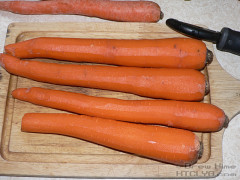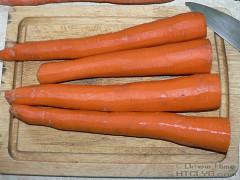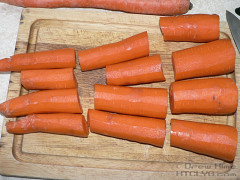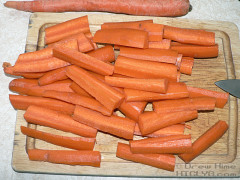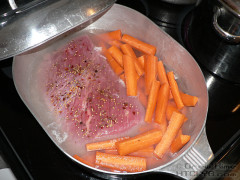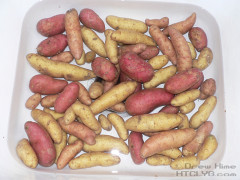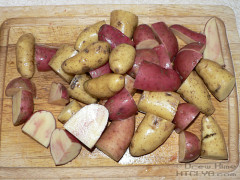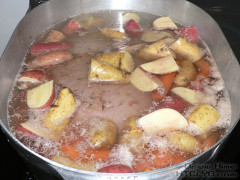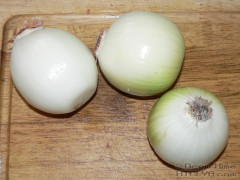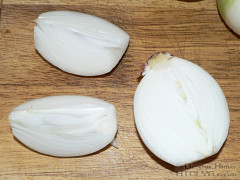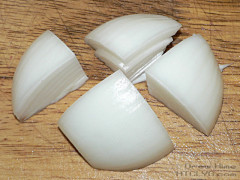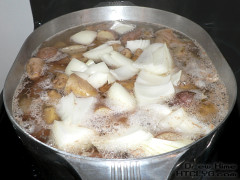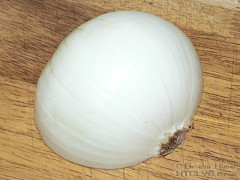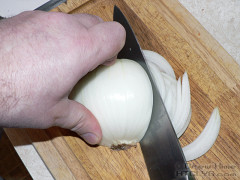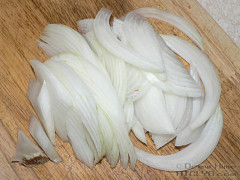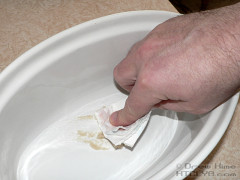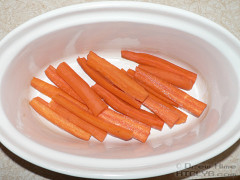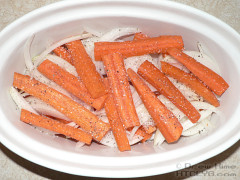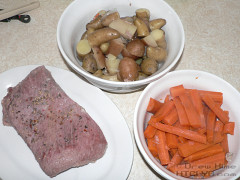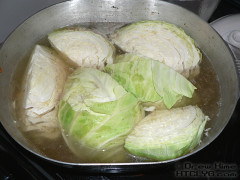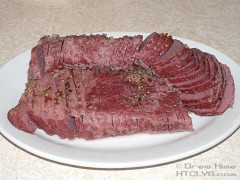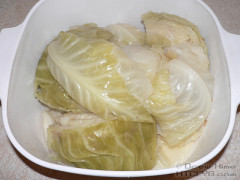Corned beef isn’t really a traditional Irish meal, it’s more of an Irish-American one. I don’t care about authenticity, I just care about having three days’ worth of leftover Reuben fixings in the fridge.
This is a great meal for feeding a whole bunch of people without spending a bunch of time in the kitchen. You can cure your own corned beef with a week of lead time, but you can also find a nice fresh brisket at your local butcher. That’s what I did here.
(See the next post for what to do with the leftovers.)
Ingredients
 3 corned beef briskets, 2-1/2 to 3-1/2 pounds each
3 corned beef briskets, 2-1/2 to 3-1/2 pounds each
5 pounds mixed red and white fingerling potatoes
5 pounds carrots
2-3 pounds onion
3 cabbage heads
For optional side dish
1 pound carrots
1/2 large onion
Directions
The main dish
Put each brisket in a separate pot. (I was feeding a large group. Cut down to one brisket if you’re serving four.) Try for pots that are just large enough to lay the brisket flat, and at least 2-3 times deeper than the brisket. Include the juices from the vacuum pack — assuming you didn’t cure your own.
Add enough water to the pot to almost cover the brisket.
Bring to a boil, then reduce heat until the water is barely bubbling.
While the water is coming to a boil, start prepping the veggies. First peel the carrots …
… cut off the stem ends …
… cut into pieces a couple of inches long …
… and cut the chinks lengthwise into slivers slightly bigger around than pencils.
Add the carrots to the pot with the beef brisket.
Next wash the potatoes thoroughly. The easiest way is to put them all in the sink and fill with cold water. Scrub each with a stiff brush until there is no dirt left on them.
Chop the potatoes into large bite-sized pieces.
By this time the brisket should have started changing color.
Add the potatoes, and enough water to almost cover them. Try to keep the veggies tucked down tight between the meat and the pan. You want to use the least amount of water that will cover everything to concentrate the flavors.
Next up is the onions. Cut the stems off and peel them.
Cut into quarters and slice out the root from the end of each quarter.
One more cut to make eighths …
… and add them to the pot.
The optional carrot dish
Along with all the veggies in the pot, I did a separate dish of carrots and onions. For this I took half a large sweet onion.
Cut thin slivers of this one lengthwise …
… so you end up with tapered wedges instead of rings.
Using a paper towel, grease a small casserole dish with bacon fat …
… until it is thoroughly coated.
Add a layer of carrots …
… and a layer of onions …
… then more carrots, onions, and carrots again. Season with salt and fresh-ground black pepper.
Add several dollops of bacon fat, a couple of tablespoons’ worth in all.
Cover this and place in a 350° oven.
The cabbage
Now back to the main dish. Core the cabbage heads and cut each wedge in half, making eighths — same as you did for the onions.
If you’ve been taking your time up til now, the corned beef has been simmering for three hours or more. If you haven’t been taking your time, do it now. Take a break until the briskets are done. Then, without dumping the water, carefully fish all the veggies and the meat out into their own bowls.
Then load the cabbage up into the water you just cooked everything else in.
Make sure the water stays at a low simmer. When you take all the meat and veggies out it will want to start boiling.
If you did the extra carrot carrot dish, turn the oven off and put the bowls of carrots and potatoes in the oven to keep warm. Otherwise set the oven on its lowest setting before putting everything in. Leave the meat out to rest.
After the cabbage has been going for about 15 minutes, take the corned beef and slice it across the grain.
You absolutely do not want to cut this with the grain unless you like stringy, chewy meat.
Once the beef is sliced, scoop the cabbage into a bowl along with a little of the water. Don’t worry about trying to drain it, let it come out in the bowl.
If you did the extra carrot dish, toss the carrots together with the onions before serving.
And that’s it.



